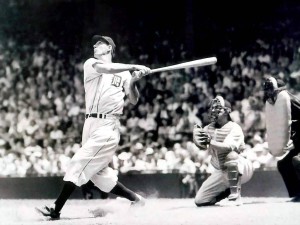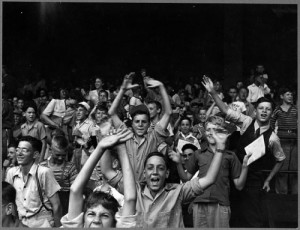by John Klima
The war years have often been characterized as a void in time where nothing significant happened. In fact, the war years featured some great teams, great races, great players and great stories and sparked a transformation that made the game modern. But in order to show this, I had to find a way to tell the story in a way that hadn’t been done before. The solution was on the field itself, in the story of three very distinct personalities – Hank Greenberg, Pete Gray and Billy Southworth Jr. All have wartime stories that reflected the journeys of so many other lives during the war. These human stories allowed me to show the interaction between the greater events of the war, how the ballplayers participated in the war and how the conflict shaped their lives, and how the war changed the game.
We see Hank Greenberg as a star player and in the mud of India and China serving with quiet distinction among the B-29 bomber crews of the 20th Air Force. We see how the most celebrated replacement player, the one-armed Pete Gray, fight his way through the pre-war and wartime minor leagues to become a major leaguer in 1945 and became an inspiration to wounded servicemen. Billy Southworth Jr. was the son of the Cardinals manager – the manager of the greatest teams of the war era – and he traded his career as a minor league prospect to serve in the dangerous skies over Europe.
Chapter 8: Bad Check
The majors already looked different as the 1942 season progressed. How to fill the seats was constantly discussed. Everybody needed a player fans wanted to come see, and that was just as true of Three Rivers as it was for the Detroit Tigers or Cleveland Indians. Without [Hank] Greenberg, the Tigers drew roughly 104,000 fewer fans, and without Feller, the Indians pulled 286,000 less.
Pete helped his little franchise draw 30,000 spectators even though they finished in sixth out of eight teams. “Gone is the sure- fire box office click, Bob Feller,” a Cleveland reporter wrote in The Sporting News, undoubtedly mournful that Feller was pitching for the Navy and not the Indians. “Gone is the fence- shattering, popular and personal exponent of batting power, Hank Greenberg.” Then, as if writing with Pete in mind, a player he had most likely never seen and never met, he wrote words Pete feared: “No freak attractions can baseball offer this summer.”
Pitchers in the 1942 American League certainly had it easier without Hank anchoring the Tigers lineup, but the government wanted him hitting cleanup for war- bond sales. On the Fourth of July, the Yankees held a 4- game lead over the Red Sox, while the Dodgers were running away with the National League pennant race, with a 9½ game lead over the Cardinals. A Yankees- Dodgers World Series rematch seemed inevitable.
A few days later, Hank was invited to join the service All-Star team to play the winner of the major league All-Star Game. Hank’s former teammate Rudy York hit a 2- run home run to win the All- Star Game at the Polo Grounds, but Hank declined the chance to play for Mickey Cochrane’s Military All-Stars in Cleveland. Instead, he continued his intensive courses at Officer’s Candidate School in an effort to do something more substantial than pose for pictures.

In August, he graduated OCS with a second lieutenant commission and was made director of sports for all Army bases throughout the nation, a big administrative job. Hank was happy for the responsibility if his beaming image in the press photos were to be believed. But deep down, Hank believed preparing the men to fight wasn’t the same as fighting himself. Posing for photos wasn’t fighting. He was a glorified cheerleader in 1942. That was hard to take. He could have been a glorified cheerleader if he was playing for the Tigers, but at least baseball during WWII had managed to salvage the season with a story line everyone loved. For that, they could thank manager Billy Southworth’s Cardinals and the National League pennant race, one that was remembered for years to come.
The Game Must Go On: Hank Greenberg, Pete Gray, and the Great Days of Baseball on the Home Front in WWII takes the readers from President Roosevelt’s Oval Office and his soul-searching decision on how to preside over wartime baseball, to the foxholes and the cockpits and the gun batteries across Europe, the Pacific and the China-Burma-India Theater. The story traces the baseball players in the great battles, from D-Day to Bastogne; from Tarawa to Tokyo. In between, the reader meets many different players from all walks of American life, and in turn, see how the game’s wartime manpower shortage sparked everything from integration, to how players were scouted and signed, to how farm systems were built, to how and why new teams moved and later emerged in new markets in new ballparks. The game we have known it for decades is what it is because of what happened to baseball in World War II. This is that story.
JOHN KLIMA is the author of The Game Must Go On: Hank Greenberg, Pete Gray, and the Great Days of Baseball on the Home Front in WWII. He was the national baseball columnist for The Los Angeles Daily News and his column writing has been recognized by the Associated Press Sports Editors. Klima’s work has also appeared in The New York Times, Yahoo! Sports, ESPN.com and The Los Angeles Times.
